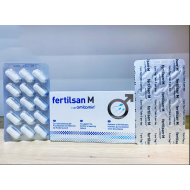
- Stock: In Stock
- Brand: Incepta Pharmaceuticals
- Product ID: Sitagliptin Phosphate
100% Secure Payment

This Item is for pre order
Sitagil 100 Tab
Description
Sitagliptin is a dipeptidyl peptidase-4 (DPP-4) inhibitor, which exerts its action by slowing the inactivation of incretin hormones. Incretin hormones, including glucagon-like peptide-1(GLP-1) and glucose-dependent insulinotropic polypeptide (GIP), are released by the intestine throughout the day and levels are increased in response to a meal. These hormones are rapidly inactivated by the enzyme, DPP-4. The incretins are part of an endogenous system involved in the physiologic regulation of glucose homeostasis. When blood glucose concentrations are normal or elevated, GLP-1 and GIP increase insulin synthesis and release from pancreatic beta cells by intracellular signaling pathways involving cyclic AMP. GLP-1 also lowers glucagon secretion from pancreatic alpha cells, leading to reduced hepatic glucose production.
Indications
Sitagil is indicated as an adjunct to diet and exercise to improve glycemic control in adults with type 2 diabetes mellitus. Sitagil is indicated as monotherapy and also indicated for use in combination with metformin, sulfonylurea or thiazolidinediones when diet and exercise plus the single agent does not result in adequate glycemic control.
Dosage & Administration
- The recommended dose of Sitagliptin is 100 mg once daily. Sitagliptin can be taken with or without food.
- For patients with mild renal insufficiency ( creatinine clearance [CrCl]>50ml/min), no dosage adjustment is required.
- For patients with moderate renal insufficiency ( CrCl.>30 to <50 ml/min women), the dose of Sitagliptin is 50 mg once daily.
- For patients with severe renal insufficiency (CrCl<30 ml/min) or with end-stage renal disease (ESRD) requiring hemodialysis or peritoneal dialysis, the dose of Sitagliptin is 25 mg once daily.
Pediatric Use:
Safety and effectiveness of Sitagliptin in pediatric patients under 18 years of age have not been established.
Geriatric Use:
No overall differences in safety or effectiveness were observed between subjects over 65 years. The drug is excreted by the kidney. Because elderly patients are more likely to have decreased renal function, care should be taken in dose selection in the elderly.
Side Effects
Adverse reactions like upper respiratory tract infection, nasopharyngitis, and headache can occur. Hypoglycemia occurs in patients treated with the combination of Sitagliptin and sulfonylurea, with or without Metformin.
Precautions
- Dosage adjustment is recommended in patients with moderate or severe renal insufficiency and in patients with ESRD.
- When used with a sulfonylurea a lower dose of sulfonylurea may be required to reduce the risk of hypoglycemia.
Use in Pregnancy & Lactation
Pregnanacy: Safety in pregnant women has not been established. Sitagliptin should be used during pregnancy only if the potential benefit justifies the potential risk of the fetus.
Nursing mothers: It is not known whether Sitagliptin is secreted in human milk, it should not be administered to a breast feeding woman.
Drug Interaction
There was a slight increase in the area under the curve and mean peak drug concentration of Digoxin with the co-administration of 100 mg Sitagliptin for 10 days.
Over Dose
In the event of an overdose, it is reasonable to employ the usual supportivemeasures as dictated by the patient’s clinical status. Sitagliptin is modestly dialyzable. Prolonged hemodialysis may be considered if clinically appropriate.
























%20Pvt.%20Ltd./Movicol-Oral-Powder-190x190.jpg)
